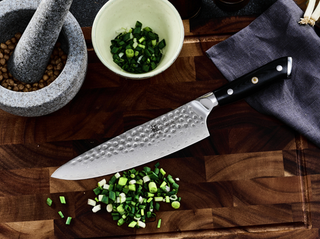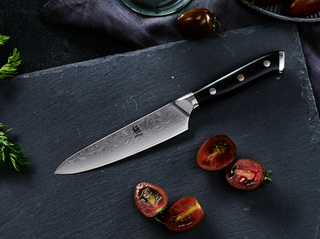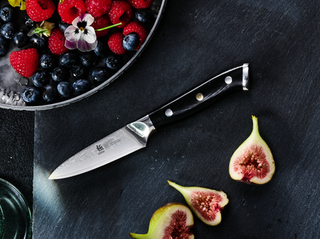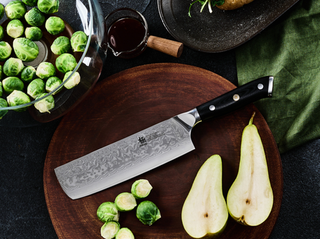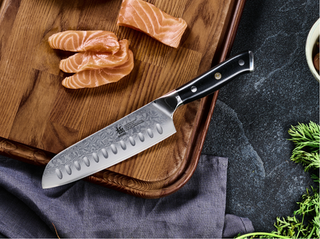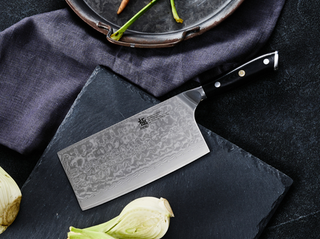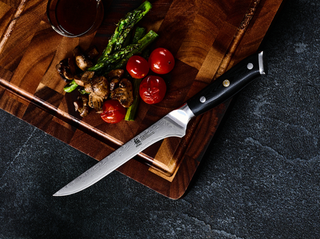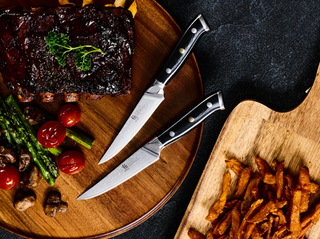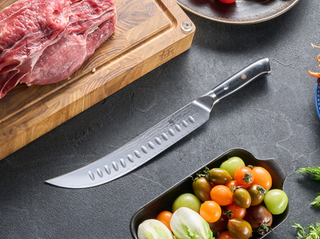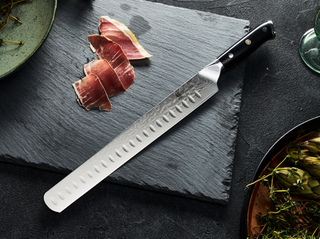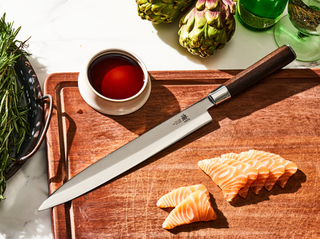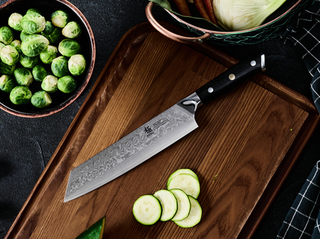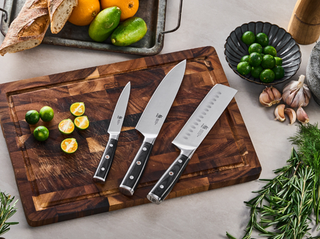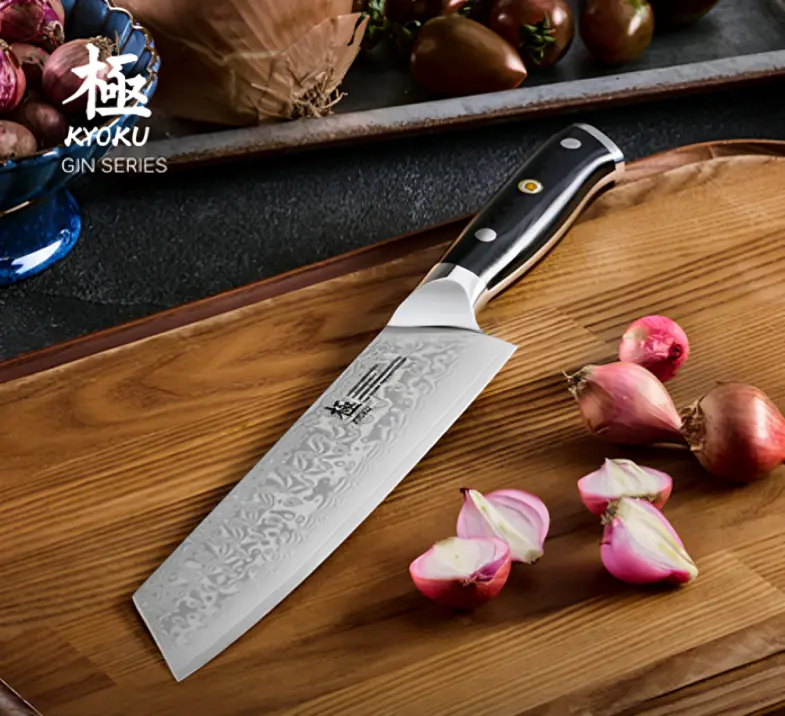I still remember the day my mentor in Tokyo handed me my first kiritsuke knife, explaining that it was time I learned to use the executive chef's knife. Years later, I find myself reaching for it almost daily in my own kitchen.
In Japan, usually only the head chefs get to use kiritsuke knives. They're like a badge of honor in professional kitchens. What makes them special is how they combine several different knives into one useful tool.
I've come to appreciate why this knife holds such a special place in Japanese culinary tradition and I want to share these knowledges to those of you who love Japanese culinary as well.
How to Tell a Kiritsuke Knife
 A kiritsuke has a long, straight blade with a unique angled tip that makes it stand out from other knives.
A kiritsuke has a long, straight blade with a unique angled tip that makes it stand out from other knives.
They're usually pretty big - about 9.5 to 12 inches long. Think of them as a 2-in-1 knife that combines what's great about fish-slicing knives (yanagiba) and vegetable knives (usuba).
Traditional kiritsuke knives are only sharpened on one side, so you need to get either a right-handed or left-handed version. But don't worry - many modern ones, including those from Kyoku, are sharpened on both sides so anyone can use them.
The blade is mostly flat, without much curve. This means you cut by pushing forward rather than rocking the knife like you might with a Western chef's knife. This design gives you amazing control when cutting all sorts of food.
Primary Uses of a Kiritsuke Knife

The cool thing about a kiritsuke is that it can do jobs that would normally require several different knives:
Protein Preparation
A kiritsuke is awesome with meat and fish:
-
It makes beautiful slices of raw fish for sashimi - the long blade lets you cut in one smooth motion
-
It's great for cutting boneless chicken or beef into even pieces
-
It slices cooked meat into thin, perfect pieces that look great on a plate
The pointed tip helps you work around bones and cut away fat with precision.
Vegetable Cutting
Even though it's a long knife, you can use a kiritsuke for detailed vegetable work:
-
It creates perfect matchstick cuts (julienne) on carrots or radishes
-
It makes super thin slices for garnishes or quick-cooking veggies
-
It dices onions cleanly without squishing them
The flat blade cuts straight down, keeping vegetables intact rather than crushing them. This actually helps preserve their flavor and texture.
Specialized Techniques
If you want to show off some real knife skills, the kiritsuke lets you do fancy Japanese cutting techniques:
-
Katsuramuki - Making paper-thin sheets from vegetables
-
Usuzukuri - Creating see-through slices of fish or vegetables
-
Katsura-muki - Creating decorative veggie sheets for garnishes
These techniques might take practice, but they're why the kiritsuke is considered a master's knife in Japan.
Proper Kiritsuke Knife Uses Techniques

Using a kiritsuke is a bit different from using regular kitchen knives:
Grip and Posture
Hold the knife with what chefs call a "pinch grip" - your thumb and index finger pinch the blade just above the handle, with your other fingers wrapped around the handle. This gives you much better control.
Stand directly above your cutting board, not off to the side. This helps you cut straight down, which is key for proper technique.
Cutting Motion
Forget the rocking motion you might use with other knives. With a kiritsuke, you'll use three main cutting actions:
-
Push-cutting: Pull the knife back slightly, then push forward and down in a straight line
-
Pull-cutting: Draw the knife toward you while pressing down
-
Thrust-cutting: Use the tip for detailed work with a forward motion
These cutting styles keep food looking nicer and preserve texture better than chopping.
Common Mistakes to Avoid
Here are the big no-nos when using a kiritsuke:
-
Rocking the knife like a Western chef's knife
-
Cutting on glass or stone surfaces (stick to wood or plastic boards)
-
Forcing the knife through tough foods instead of using proper technique
-
Twisting the blade while cutting, which can chip the edge
-
Trying to cut bones or frozen food
Avoid these mistakes and your knife will stay sharp and work great for years.
Kiritsuke vs. Other Japanese Knives
It helps to know how the kiritsuke compares to other Japanese knives:
Kiritsuke vs. Gyuto
Both are all-purpose knives, but:
The gyuto (Japanese chef's knife) has a curved edge that's good for rocking cuts. It's like a Western chef's knife but thinner and harder.
The kiritsuke has a flatter edge with that angled tip, and works best with straight push-cuts. It's better for precision work but takes more skill to use well.
Kiritsuke vs. Yanagiba
Both can slice fish for sashimi, but:
The yanagiba only does one job - slicing raw fish with its long, narrow blade.
The kiritsuke is pretty good at slicing fish but can do lots of other tasks too. It's more versatile but maybe not quite as specialized.
Kiritsuke vs. Bunka
These knives both have an angled tip, but:
The bunka is shorter (about 6-7 inches) with a wider blade, making it easier for everyday use.
The kiritsuke's longer blade is better for slicing bigger ingredients but needs more skill to control well.
Foods Best Cut with a Kiritsuke
Some foods really show off what a kiritsuke can do:
1. Fish and Seafood
The long, straight blade creates clean cuts through raw fish without tearing the delicate flesh. This is super important for dishes like sashimi where appearance matters.
2. Boneless Meats
Chicken breasts, beef tenderloin, and pork loins are perfect for the kiritsuke. It creates even slices without sawing, which keeps the meat looking prettier.
3. Precision Vegetable Cuts
Ingredients like cucumbers, daikon radish, and carrots are perfect for showing off the kiritsuke's ability to create paper-thin slices or perfect matchstick cuts.
Kiritsuke Knife Tips for Home Cooks
While traditionally just for master chefs, modern kiritsukes are becoming more popular with home cooks:
Starting with a Double-Bevel Kiritsuke
If you're new to Japanese knives, get a double-beveled kiritsuke (sharpened on both sides). These are much easier to use while still giving you that special kiritsuke shape and cutting ability.
Building Skills Gradually
Build your kiritsuke skills step by step:
- Start with basic straight cuts on vegetables
- Move on to precision tasks like fine dicing and matchstick cuts
- Finally try protein preparation and fancier techniques
This gradual approach builds confidence and reduces the chance of accidents.
Common Questions About Kiritsuke Knife Uses
1. Can a kiritsuke replace my chef's knife?
A kiritsuke can handle many of the same jobs as a chef's knife, especially precision cutting. However, its flat edge isn't great for rocking cuts, and it's not made for heavy tasks like cutting through bones. Most home cooks find it works best alongside a regular chef's knife.
2. Is a kiritsuke suitable for beginners?
Traditional single-bevel kiritsukes need quite a bit of skill and are better for experienced cooks. But modern double-beveled versions are much more beginner-friendly, as long as you're willing to learn proper technique and maintenance.
3. How often should I sharpen my kiritsuke?
For most home cooks, honing before each use and sharpening every 1-2 months is enough, depending on how often you use it. Professional chefs might need to sharpen weekly or even daily.
Further Reading: How to Sharpen a Knife with Whetstone
4. Can I use a kiritsuke for Western cooking?
Absolutely! While it was designed for Japanese cuisine, a kiritsuke is great for many Western techniques that need precision. It's especially good for preparing ingredients for French and Italian dishes that need uniform cutting.
Conclusion

The kiritsuke knife brings the precision of Japanese culinary tradition to your kitchen. By learning what it is used for and how to use it, you'll be able to make cuts that transform ordinary ingredients into restaurant-quality components.
The kiritsuke is a knife that grows with your skills. With practice, this master's knife can turn meal prep into something that looks as good as it tastes.
